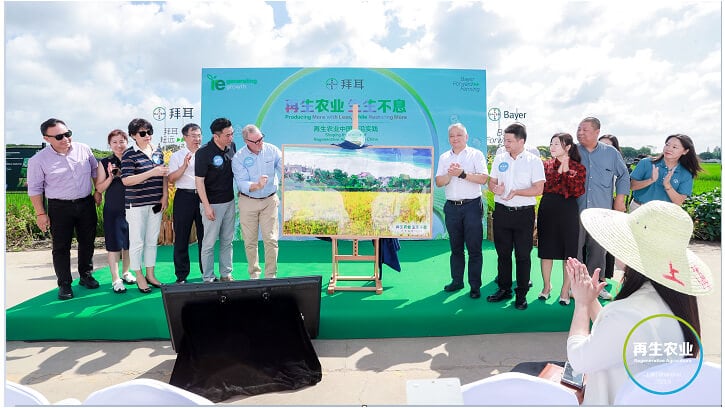The Chinese government has implemented various policies and initiatives to promote technological advancements, invest in R&D and encourage collaboration between the government, industry, and research institutions.
China’s agtech sector has also embraced precision agriculture, Internet of Things (IoT) and big data technologies, vertical farming, indoor agriculture, agricultural e-commerce, robotics and automation, biotechnology and genomics, and food safety and traceability.
While China's agtech industry is rapidly evolving and poised to play a significant role in shaping the future of agriculture, there still remain challenges when it comes to awareness, funding, scaling and sustainability.
These are challenges that organisations like Ag-Tech Future and its Sustainable Future Frontier Technology Promotion Center (also called the Sustainable Future Center) aim to tackle by uniting diverse participants — such as agri-food companies, start-ups, research institutions and government agencies — to jointly promote the sustainability of feed, fibre and fuel.
Less knowledge, less funding
According to AgTech Future chairman Ryan Xue, the lack of awareness and recognition of the value and potential of sustainable agtech solutions among investors and policymakers is one of the biggest obstacles to obtaining sufficient funding.
He told AgTechNavigator: “Many investors are still risk-averse and prefer traditional or proven business models over innovative or disruptive ones, and policymakers are still unaware or sceptical of the benefits and feasibility of sustainable agri-tech solutions for addressing social and environmental issues.”
He added that sustainable agtech solutions had to be accessible to farmers, businesses and consumers alike in order for a commercially viable “food system transformation” to happen, saying, “We have been working hard to raise awareness and educate investors and policymakers about the opportunities and advantages of sustainable agtech solutions and showcasing successful cases and best practices from our projects and partners.”
Sustainability across all sectors
At the central level, the Chinese government has shown considerable commitment to sustainability as a national priority, evident in the policies and initiatives launched in recent years, such as The Greater Food Concept and the China Agri-food Sustainability Plan.
However, there are still gaps and inconsistencies among different levels and sectors of government in terms of the understanding, coordination and enforcement of sustainability efforts in agtech.
Xue said that in order to close these gaps, AgTech Future is working to increase cooperation between government and industry by providing policy advice, technical assistance, capacity-building and stakeholder engagement.
“This is helping to facilitate cross-sectoral collaboration and alignment on sustainability issues and ensure that the Chinese government is taking the necessary steps to promote sustainability in agricultural modernisation,” he said.
He further acknowledged that true sustainability — and sustainable growth — requires achieving a balance between environmental, economic and security priorities. “Agri-food is a strategic sector that touches all aspects of national security and sustainable growth, which are key to reaching China's most strategic, long-term goals.
“If we look individual supply chains and companies, agriculture and food represent 34% of global greenhouse gas emissions. Therefore, one key focus is reducing methane emissions, whose global warming impact is 20 times that of CO2’s,” said Xue. Furthermore, agriculture accounts for 40% of CO2 emissions, mostly from Industrial farming and rice cultivation.
Xue then pointed out the ways in which these different areas could complement one another, such as by harnessing biotechnology to improve crop yield and quality and reduce pesticide use and greenhouse gas emissions. Smart agriculture can also be used to optimise resource allocation and management while increasing productivity and resilience.
At the same time, alternative proteins can diversify food sources and reduce animal welfare issues while meeting consumer preferences and nutritional needs. Additionally, food safety technologies can be employed to ensure food quality and safety.
Strategies and support for scaling
Scaling is another area of great importance, as successful scaling can meet the diverse, complex needs of China’s vast agricultural sector. According to Xue, the agricultural supply chain’s fragmentation and low efficiency are among the key obstacles to scaling agricultural innovations in the country.
Other significant challenges include a lack of infrastructure and standardisation for technology adoption and dissemination, the low level of digital literacy and skills among farmers and rural workers, and the uneven distribution of resources and opportunities across different regions.
Xue believes a multi-pronged approach is necessary to overcome these hurdles — this includes government collaboration to establish a clear regulatory framework for agricultural modernisation and creating networks and platforms for different agtech stakeholders to connect with one another, as well as training and education programmes to enhance digital capabilities.
At the same time, there is a need to develop customised solutions to suit local needs, leverage cross-border cooperation to access new markets and technologies, and address the sustainability issues arising from agtech innovation (such as environmental impact, social equity and ethical standards).
Xue said, “In addition to these strategies, creating a supportive environment for agtech innovation is also important. This includes providing funding, research support and regulatory clarity for agtech companies. It also means creating a culture of innovation and risk-taking in the agricultural sector.”
Significant strides
Despite the aforementioned challenges, there are some promising developments in progress in China’s agri-tech sector, including the use of artificial intelligence (AI), big data, and blockchain to improve traceability, quality control, and efficiency across the food supply chain.
Xue also believes the development of novel biotechnologies — such as gene editing, synthetic biology and cellular agriculture — to create new products and solutions for food safety, nutrition, and health could lead to the development of new types of food that are more nutritious, sustainable and affordable.
He said, “The adoption of smart farming systems, such as precision agriculture, drones and sensors, will help improve crop yields, reduce pesticide use, optimise crop production, reduce environmental impact and increase resilience against climate change. This could help make China's food production more sustainable in the future.”
Other developments, such as more sustainable and ethical protein products (i.e., plant-based or cultured meats) and the growth of China’s aquaculture industry — already one of the world’s largest — could help meet growing global demand for alternative protein sources and seafood.
“These developments have the potential to significantly impact the industry by enhancing productivity, competitiveness and sustainability, as well as by helping to improve food security, reduce environmental impact and create new jobs,” Xue said.
Policy-driven innovation
In recent years, the Chinese government has launched several policies to promote agri-tech innovation, address the challenges of food security, environmental protection and rural development, and provide funding, research support and regulatory clarity.
One such policy is the National Agri-Food Innovation Plan for the 14th Five-Year Plan, which focuses on agri-tech innovations and identifies the key areas for agtech R&D, such as smart farming, biotechnology and digital agriculture. Already, it has allocated billions of dollars in funds and incentives to agri-tech enterprises, research institutes and universities to foster collaboration and innovation.
Another national policy worth mentioning is the China Agri-food Sustainability Plan, which was introduced in 2021. This plan sets out the government's goals for sustainable agriculture and food production, covering aspects such as soil health, water conservation, biodiversity, climate resilience and animal welfare. It also supports the innovation and application of agtech technologies to enhance productivity, resource efficiency and environmental performance.
More recently, the country’s Greater Food Concept was rolled out in 2022 to outline the government’s vision for a more sustainable and equitable food system based on circular economy principles, green development and social justice. It also encourages the development and adoption of agtech solutions that can improve food quality, safety and efficiency, as well as reduce waste and emissions.
In addition to these policies, the Chinese government is also investing in agtech infrastructure to build new incubators, research facilities and training centres, and is working to improve the regulatory environment for agtech companies.
Xue said, “The agri-food sector is the missing piece to reaching China's ambitious goals to peak carbon emissions before 2030. Achieving environmental goals, protein security and sound nutrition is possible only through innovation that is economically viable and internationally competitive.”




